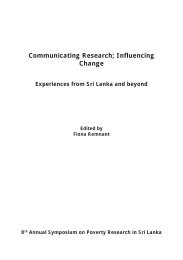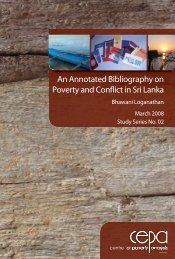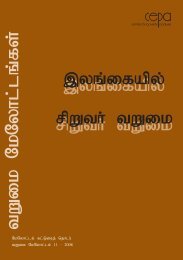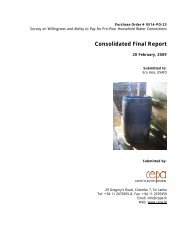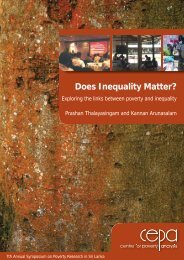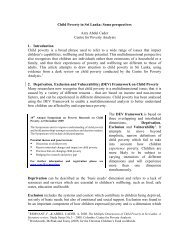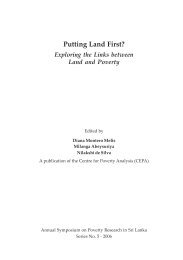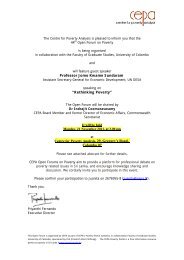Involuntary Displacement and Resettlement â Policy and ... - CEPA
Involuntary Displacement and Resettlement â Policy and ... - CEPA
Involuntary Displacement and Resettlement â Policy and ... - CEPA
- No tags were found...
You also want an ePaper? Increase the reach of your titles
YUMPU automatically turns print PDFs into web optimized ePapers that Google loves.
Attention to host communities: <strong>Displacement</strong> <strong>and</strong> resettlementdynamics have been subjects of scholarly research for over twodecades. For the past 10 years, Sri Lankan scholars <strong>and</strong> activists haverepeatedly documented the adverse relations that develop betweendisplaced <strong>and</strong> host communities. This local knowledge <strong>and</strong> experiencewas not acted upon by donors/government agencies involved intsunami resettlement. Consultations with local communities should bea routine step in the resettlement/relocation process so that localcommunities do not feel ambushed by new settlements entering theirarea. Attention to the potential feelings of local communities <strong>and</strong>possible conflicts that could emerge from resettlement schemes is oneway to put the principle of ‘do no harm’ into practice.Improving self-settlement schemes:Training: Comprehensive training to explain the nuances of everystep in the process <strong>and</strong> the paperwork accompanying each step inthe process should be undertaken, once a family has chosen theresettlement package that is correct for them.Mentoring/Partnering individuals/families with a mentor: Families intransitional shelter who have exceptional circumstances or, as timeunfolds (as was the case here), are struggling noticeably with theprocess should be assigned mentors to guide them through theprocess. This is not the kind of assignment that needs to be givento the traditional NGO ‘protection’ officer. In the case of Colombo’sself-settlement, final year law students would have benefitedtremendously as well as gained a considerable level of knowledgeabout the country’s property law had they been paired with a familythat was struggling to negotiate the compensation process <strong>and</strong>properly file the correct document for self-settlement.Note: The author wishes to thank officials from UNOPS, COHRE <strong>and</strong> IOM for sharing theirexperiences <strong>and</strong> giving perspective to the tsunami reconstruction process. She is grateful to theUNOPS TSST assessment team for their detailed note-taking during data collection <strong>and</strong> theircommitment to making Sri Lanka a better place for the poor <strong>and</strong> disenfranchised. Theseindividuals are: Ch<strong>and</strong>ima B<strong>and</strong>ara, Kalpika Kumudu Kumari, <strong>and</strong> A. Hilmy Aftar. Special thanksare due to Ms. Alice Salmon for her tirelessness in data quality control, Srisk<strong>and</strong>avel Thavavellwho assisted in data processing, <strong>and</strong> Ms. Kumudu Kumari for translating Sinhala documents intoEnglish. This section is based on a paper entitled, “Transitioning Nowhere: Rights, Claims, <strong>and</strong>Entitlements in Post-Tsunami Housing Reconstruction” presented at the British Association ofSouth Asian Studies (BASAS), University of Leicester, March 2008 <strong>and</strong> a presentation given atthe <strong>CEPA</strong> 9th Annual Poverty Symposium in December 2008.Kanchana Ruwanpura providedseveral insightful comments on earlier drafts.204



